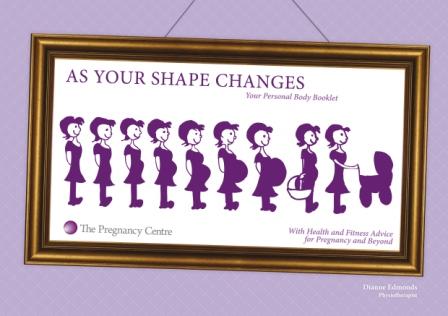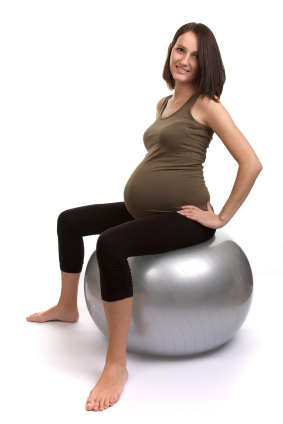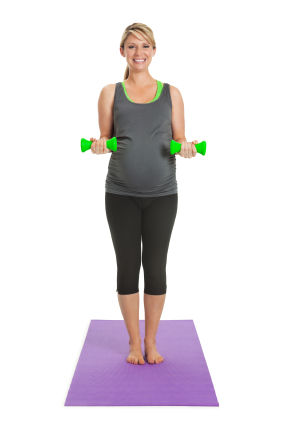Exercise during Pregnancy

There is no doubt about it, pregnancy is physically demanding! Regular exercise is an essential way of helping your body cope with the increased demands on your joints, muscles, heart, circulation, and lungs.
Benefits of Exercise in Pregnancy
o Regular exercise can help reduce back pain, improve or maintain muscle tone, reduce leg cramps, swelling and constipation and improve sleep patterns. When you exercise regularly it can help you to feel better, have more energy and tune in more to the changes happening in your body as your baby grows (or your babies if you are having twins or more).
o Regular exercise during pregnancy can reduce your level of fatigue due to improved sleep, reduced anxiety, reduced feeling of pain (pain perception), help reduce excess tension in your body (neuromuscular tension) due to the tranquillizer effect of exercise and improved fitness.
Do's and Don'ts of pregnancy exercise
While you are pregnant it is important to take special precautions and considerations with your exercise programs. Some essential guidelines are listed below to help you make safe choices for you and your baby while you are pregnant.
The Do’s
o Do Consult Your Doctor, Specialist or Midwife ~ When starting a new exercise program, or continuing with your current exercise program in pregnancy, it is important to consult with your Doctor, Obstetrician, or Medical Specialist and/or Midwife. If you have any specific problems, or discomforts, you should make sure you discuss these to determine if you need to take any special precautions. The type and amount of exercise that you normally do and have done recently will influence the advice that your Doctor or Midwife provides when giving you advice regarding exercise during pregnancy.
o Watch Your Exertion Level ~ Rather than monitoring by heart rate, the current recommendations for pregnant women performing exercise to ensure that you don't over exert yourself, and are able to keep proper form throughout is use the RPE (rating of perceived exertion scale), and to exercise at a score of between 12 -14 on a 6 - 20 scale, such as the Borg Scale. Exercise at your own comfort level.
o Wear A Bra ~ Always wear a good supportive bra while exercising. Check your bathing costume for support also if you are doing water aerobics. You may wish to wear a bra under your costume.
o Eat Carbohydrates Before Exercise ~ Blood sugar levels can fluctuate rapidly during pregnancy. Always eat food containing carbohydrates 1 - 2 hours before exercising. Carry juice with you to drink if you feel faint or dizzy. If this occurs, slow down or stop exercising.
o Do Pelvic Floor Exercises ~ Pelvic floor exercises are an essential part of any good pregnancy fitness program. When you exercise your pelvic floor before, during and after pregnancy you will reap many benefits. Knowing how your muscles feel, improving your technique, strength and tone and being sure on how to get started on them getting back into shape after the birth are all benefits of investing time into knowing and learning about your pelvic floor AND DOING your exercises. If you are unsure how to exercise your pelvic floor, refer to the checklist in As Your Shape Changes . You can learn more about your pelvic floor through our Pregnancy and Postnatal Pelvic Floor Connection ebooklet and get more ideas for different positions in which you can work your pelvic floor in our FREE handout - Pregnancy Pelvic Floor Exercises
o Do Pregnancy and Postnatal Abdominal Bracing Exercises ~ Stomach curls and crunches should cease as soon as you are pregnant and Pregnancy Abdominal Bracing exercises are an excellent choice and can be done throughout your pregnancy, providing you learn them well and you don't hold your breath during this exercise.
Pregnancy Abdominal Bracing exercises help to keep your abdominal muscles toned and support your baby. Together with your pelvic floor and back muscles they form your 'core'.
Do you know how to do Pregnancy Abdominal Bracing?
You can learn it and Postnatal Abdominal Bracing which is great if you are keen to get your shape back after the birth, by using our booklet, As Your Shape Changes.
 Are you pregnant and looking for a place to start to keep your body in shape? Do you want to know how to carefully care for your body and your baby? Are you looking for some simple step by step instruction? If your answer is YES to any of these questions our booklet As Your Shape Changes will help you to do all of this and much MORE.
Are you pregnant and looking for a place to start to keep your body in shape? Do you want to know how to carefully care for your body and your baby? Are you looking for some simple step by step instruction? If your answer is YES to any of these questions our booklet As Your Shape Changes will help you to do all of this and much MORE.
o Monitor Your Rectus Diastasis ~ This is the "gap" that occurs between your abdominal muscles during pregnancy. You can decrease the width of this gap by using correct posture and ceasing abdominal curls and crunches. It is wise to keep a regular check on the width of this gap. This checking process is described in the booklet, As Your Shape Changes and charts are provided to monitor your progress during and after pregnancy.
o Watch Your Posture ~ Always maintain correct form and posture during exercise. Use Pregnancy Abdominal Bracing and be aware of your back at all times. To maintain good posture when standing, lift yourself up tall, stand with your abdominal muscles gently drawn in, keep breathing evenly, gently draw your shoulder blades back and nod your chin in. Work to check into this position regularly during the day. Pregnancy Abdominal Bracing Exercises are outlined in As Your Shape Changes.

The Do Not's
o Do Not Overheat ~ AVOID exercise on extremely hot days. Position yourself near the air conditioner or fan for aerobics classes. Do not use the solarium, spa, steam room or overheated pools. Keep fluid intake up before, during and after exercise. Drink small amounts of fluid frequently. Avoid exercise in the heat of the day.
o Do Not Exercise on your back after 16 weeks of pregnancy ~ There are a number of exercise choices that can be done using a ball, in standing, lying on your side and on your hands and knees, that you can use after 16 weeks of pregnancy. Choose exercises/stretches that are done while seated or upright. There are some Pregnancy Abdominal Bracing and leg exercises that can be modified and performed on your side as an alternative to lying on your back. Lying on your back can cause the weight of your growing baby to press down on the major veins to your heart, and can result in you feeling dizzy or lightheaded and can reduce the blood flow to you and your baby. This is why it is recommended to avoid the position for exercise after 16 weeks, but if you find yourself in this position when you wake up, don't be too concerned. There is less demand on your body during sleep, and your body will usually tell you to move when you need to. Also, your examinations and ultrasound checks are performed usually with you on your back, although sometimes your midwife or your doctor may place a pillow behind you so you are rolled slightly onto your side, if need be.
Be Aware of The Effects of Pregnancy Hormones
Pregnancy hormones soften your joints, which may increase the risk of injury during pregnancy. Be careful not to overstretch when doing your stretches and avoid contact sports after the first trimester, or on advice of your medical practitioner. Always lift your pelvic floor and brace your abdominal muscles when lifting and maintain good posture.
For more information on how to reduce the risk of injury and minimize strain to your joints during and after pregnancy read Pregnancy Exercise Guidelines and Postnatal Exercise Guidelines
Ideal exercises during pregnancy (if no complications)
.jpg.aspx)
o Walking.
o Low Impact Aerobics.
o Water Aerobics.
o Pregnancy Exercise Classes.
o Cycling.
o Swimming.
o Light weight training (see an instructor who has specific knowledge about pre and post natal exercises for assistance with your programme).

Exercises to avoid during pregnancy
o Heavy weights.
o Bouncing ~ especially star jumps, or similar activities.
o Contact sports.
o Excessive breaststroke at the end of your pregnancy, as this puts stress on your pelvis.
o Any activities, or exercises which cause pain.
This summary of guidelines was prepared by: Sarah Tate, Bachelor of Physical Education, Diploma of Education. 2000©. Reviewed and updated 2011.
Copyright 2011-2020. Demac Resources Pty Ltd. www.thepregnancycentre.com.au
Click here to download a free factsheet called "Pregnancy and Exercise"